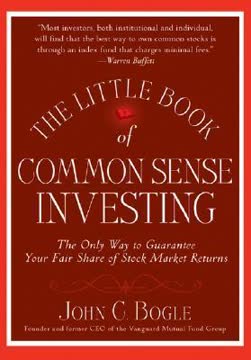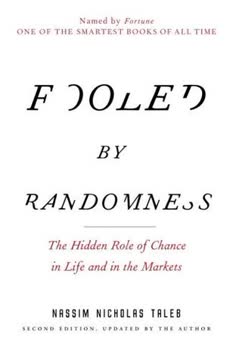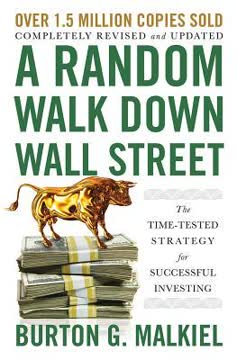Key Takeaways
1. Embrace passive investing for superior returns and peace of mind
"By periodically investing in an index fund, the know-nothing investor can actually outperform most investment professionals."
Passive investing wins. Decades of academic research and real-world evidence demonstrate that passive investing consistently outperforms active management strategies. This approach involves investing in low-cost index funds or exchange-traded funds (ETFs) that track broad market indices, rather than trying to pick individual stocks or time the market.
Key benefits of passive investing:
- Lower costs (management fees, transaction costs)
- Greater tax efficiency
- Reduced emotional decision-making
- More time to focus on other aspects of life
By embracing passive investing, investors can achieve market returns while avoiding the pitfalls of active management, such as high fees, frequent trading, and underperformance. This strategy aligns with Warren Buffett's advice and provides a simple, effective path to long-term wealth accumulation.
2. Understand market efficiency and the futility of active management
"The most important quality for an investor is temperament, not intellect."
Markets are efficient. The Efficient Market Hypothesis posits that security prices reflect all available information, making it extremely difficult for active managers to consistently outperform the market after accounting for fees and expenses. This concept underpins the rationale for passive investing.
Evidence against active management:
- Lack of persistent outperformance
- High fees erode returns
- Difficulty in timing the market
- Emotional biases lead to poor decision-making
Understanding market efficiency helps investors resist the temptation to chase "hot" stocks or follow market predictions. Instead, it encourages a disciplined, long-term approach focused on capturing market returns through broad diversification and low-cost investment vehicles.
3. Develop a comprehensive financial plan tailored to your goals
"Those who fail to plan, plan to fail."
Holistic planning is crucial. A well-designed financial plan goes beyond just investments, incorporating estate planning, tax strategies, risk management, and insurance needs. This comprehensive approach ensures that all aspects of your financial life work together cohesively to achieve your goals.
Key components of a comprehensive financial plan:
- Clear, measurable financial objectives
- Asset allocation strategy
- Risk management (insurance)
- Estate planning
- Tax optimization strategies
- Regular review and adjustment
By developing a tailored financial plan, investors can make informed decisions that align with their long-term objectives, risk tolerance, and unique circumstances. This structured approach helps maintain discipline during market volatility and provides a roadmap for financial success.
4. Determine your optimal asset allocation based on risk tolerance
"Do not take more risk than you have the ability, willingness, or need to take."
Balance risk and return. Asset allocation, the division of your portfolio between stocks, bonds, and other asset classes, is the primary driver of long-term investment returns and risk. Determining the right mix depends on your unique ability, willingness, and need to take risk.
Factors influencing asset allocation:
- Time horizon
- Financial goals
- Income stability
- Risk tolerance
- Current financial situation
A well-designed asset allocation strategy helps investors strike the right balance between growth potential and downside protection. It provides a framework for making investment decisions and helps maintain discipline during market fluctuations, increasing the likelihood of achieving long-term financial objectives.
5. Diversify globally across multiple asset classes for long-term success
"Diversification is always working; sometimes you'll like the results and sometimes you won't."
Spread your risks. Global diversification across multiple asset classes reduces portfolio risk and enhances long-term returns. By investing in a mix of domestic and international stocks, bonds, real estate, and commodities, investors can capture returns from various market segments while minimizing the impact of poor performance in any single area.
Benefits of global diversification:
- Reduced portfolio volatility
- Exposure to growth opportunities worldwide
- Protection against country-specific risks
- Potential for higher risk-adjusted returns
Embracing global diversification helps investors avoid the pitfalls of home country bias and over-concentration in familiar assets. It provides a more robust portfolio structure capable of weathering various economic and market conditions.
6. Implement disciplined rebalancing and tax management strategies
"The strategy to get rich is entirely different from the strategy to stay rich."
Maintain your target allocation. Regular portfolio rebalancing and tax-efficient management are crucial for long-term investment success. Rebalancing involves periodically adjusting your portfolio back to its target asset allocation, while tax management strategies aim to minimize the impact of taxes on investment returns.
Key rebalancing and tax management techniques:
- Periodic portfolio review (e.g., annually or when allocations drift significantly)
- Tax-loss harvesting
- Asset location optimization (placing investments in the most tax-efficient accounts)
- Careful timing of buys and sells to minimize tax impact
Implementing these strategies helps maintain your desired risk profile, captures gains from outperforming assets, and maximizes after-tax returns. Disciplined execution of these techniques can significantly enhance long-term portfolio performance.
7. Focus on the "big rocks" in life, not just investment returns
"The truth this illustration teaches us is that if you do not put the big rocks in first, you can never get them in."
Prioritize what matters most. While achieving financial goals is important, it's crucial to maintain perspective and focus on the truly meaningful aspects of life. Passive investing frees up time and mental energy that can be redirected towards family, personal growth, community involvement, and other "big rocks" that provide life satisfaction.
Benefits of a balanced approach:
- Reduced stress and anxiety about investments
- More time for meaningful relationships and activities
- Improved overall life satisfaction
- Better alignment between financial goals and personal values
By adopting a passive investment strategy and maintaining a well-designed financial plan, investors can achieve their financial objectives while still prioritizing the most important aspects of their lives. This balanced approach leads to greater overall well-being and a more fulfilling life journey.
Last updated:
FAQ
1. What is "Think, Act, and Invest Like Warren Buffett" by Larry E. Swedroe about?
- Practical Investment Guide: The book distills Warren Buffett’s investment philosophy into actionable steps for everyday investors, focusing on evidence-based, prudent strategies.
- Passive vs. Active Investing: It advocates for passive investing through index funds, explaining why this approach outperforms most active strategies.
- Behavioral Insights: Swedroe explores the psychological pitfalls that derail investors and offers advice on developing the right temperament and discipline.
- Comprehensive Financial Planning: The book extends beyond investing, emphasizing the importance of integrated financial, estate, tax, and risk management planning.
- Life Lessons: Swedroe connects investment success to broader life satisfaction, urging readers to focus on what truly matters—“the big rocks” in life.
2. Why should I read "Think, Act, and Invest Like Warren Buffett" by Larry E. Swedroe?
- Buffett’s Wisdom Simplified: The book translates Warren Buffett’s complex investment principles into simple, actionable advice for non-experts.
- Evidence-Based Approach: Swedroe relies on decades of academic research and real-world data, not just opinions or anecdotes.
- Avoiding Common Mistakes: Readers learn how to sidestep the costly errors most investors make, such as market timing and chasing forecasts.
- Holistic Financial Guidance: It covers not just investing, but also planning for taxes, insurance, estate, and life goals.
- Improved Quality of Life: By adopting these strategies, readers can spend less time worrying about markets and more time on meaningful pursuits.
3. What are the key takeaways from "Think, Act, and Invest Like Warren Buffett"?
- Passive Investing Wins: Most investors, including professionals, underperform the market; low-cost index funds are the best choice for the majority.
- Ignore Market Noise: Forecasts and market timing are distractions—Buffett himself ignores them, and so should you.
- Discipline and Planning: Success comes from having a written investment plan and sticking to it, especially during market turmoil.
- Diversification is Essential: Broad diversification across asset classes is the only “free lunch” in investing.
- Integrated Life Planning: Financial success is about more than returns; it’s about aligning your investments with your life’s priorities.
4. How does Larry E. Swedroe define and recommend passive investing in "Think, Act, and Invest Like Warren Buffett"?
- Index Funds as Core: Swedroe recommends investing in low-cost index funds or passively managed funds, which track broad market segments.
- Avoiding Active Management: He explains that active strategies—stock picking and market timing—rarely outperform after costs and taxes.
- Evidence-Based Rationale: The book cites research showing that passive investors consistently achieve better net results than active investors.
- Simplicity and Discipline: Passive investing is simple to implement and requires the discipline to stay the course, regardless of market conditions.
- Market Returns, Not Average: Passive investing delivers market returns, which are superior to the average investor’s results due to lower costs and better behavior.
5. What are the main behavioral mistakes investors make, according to "Think, Act, and Invest Like Warren Buffett"?
- Market Timing Temptation: Investors often try to time the market, buying high and selling low, which erodes returns.
- Overreacting to News: Many react emotionally to bad news, not realizing that markets already price in expectations.
- Stage-One Thinking: Swedroe warns against focusing only on immediate crises without considering long-term responses and solutions.
- Ignoring Written Plans: Investors frequently abandon their investment plans during periods of fear or greed.
- Seeking Forecasts: Relying on market predictions or “expert” opinions leads to poor decisions, as even professionals can’t forecast accurately.
6. How does "Think, Act, and Invest Like Warren Buffett" recommend building a well-diversified portfolio?
- Asset Class Diversification: Swedroe advocates spreading investments across U.S. and international stocks, small-cap and value stocks, bonds, real estate, and commodities.
- Risk Factor Exposure: The book emphasizes diversifying by risk factors (size, value, geography) to reduce volatility and improve returns.
- Use of Mutual Funds/ETFs: He recommends mutual funds and ETFs for effective diversification, as owning individual securities increases uncompensated risk.
- Rebalancing: Regularly rebalance the portfolio to maintain target allocations and risk levels.
- Avoiding Concentration: Don’t overinvest in familiar companies or your employer’s stock, as this increases risk without additional expected return.
7. What is the role of financial planning and an Investment Policy Statement (IPS) in Swedroe’s approach?
- Written Roadmap: An IPS serves as a contract with yourself, outlining objectives, asset allocation, and rebalancing rules.
- Living Document: The plan should be reviewed and updated as life circumstances or market assumptions change.
- Integrated Planning: Swedroe stresses integrating investment planning with estate, tax, and risk management (insurance) planning.
- Contingency Planning: The IPS should include actions to take if the portfolio underperforms, such as reducing spending or delaying retirement.
- Goal Tracking: Clearly defined goals and regular progress reviews help maintain discipline and make necessary adjustments.
8. How does "Think, Act, and Invest Like Warren Buffett" address risk and asset allocation decisions?
- Ability, Willingness, Need: Swedroe recommends assessing risk based on your ability (time horizon, job stability), willingness (emotional tolerance), and need (required return) to take risk.
- Human Capital Consideration: Factor in the stability and correlation of your future income (labor capital) when deciding asset allocation.
- Role of Bonds: Bonds should anchor the portfolio, reducing overall risk; only take risks with stocks.
- Liquidity Needs: Maintain a cash reserve for emergencies, typically six months of expenses.
- Avoiding Uncompensated Risk: Only take risks for which you are compensated; diversify away risks like individual stock or sector exposure.
9. What does Swedroe say about hiring a financial advisor versus being a do-it-yourself investor?
- Self-Assessment: He provides five questions to determine if you have the knowledge, skills, and temperament to manage your own investments.
- Value of Advisors: Good advisors add value through integrated planning, discipline, education, and freeing up your time for more important pursuits.
- Fiduciary Standard: Only work with advisors who adhere to a fiduciary standard, putting your interests first and avoiding commission-based compensation.
- Evidence-Based Advice: Choose advisors who base recommendations on peer-reviewed research, not opinions or sales pitches.
- Due Diligence: Perform thorough research on advisors, including checking credentials, compensation structure, and client references.
10. What are the "30 Rules of Prudent Investing" outlined in "Think, Act, and Invest Like Warren Buffett"?
- Risk Management: Don’t take more risk than you can handle or need; understand all risks before investing.
- Simplicity and Diversification: Avoid complex products, diversify broadly, and stick to low-cost, passive investments.
- Discipline and Planning: Have a written plan, rebalance, and integrate investment with estate and insurance planning.
- Skepticism of Forecasts: Ignore market predictions and “this time is different” thinking; base decisions on evidence.
- Advisor Selection: Work only with fiduciary, fee-only advisors, and separate advisory, custodial, and money management roles.
11. What are the best quotes from "Think, Act, and Invest Like Warren Buffett" and what do they mean?
- “Our favorite holding period is forever.” – Warren Buffett’s advice to focus on long-term investing, not short-term trading.
- “Investing is simple, but not easy.” – The principles are straightforward, but emotional discipline is challenging.
- “The only free lunch in investing is diversification.” – Diversifying across asset classes reduces risk without sacrificing expected return.
- “Hope is not an investment strategy.” – Decisions should be based on evidence, not wishful thinking.
- “The most important quality for an investor is temperament, not intellect.” – Emotional control is more crucial than intelligence for investment success.
12. How does "Think, Act, and Invest Like Warren Buffett" connect investing to achieving life goals and happiness?
- Focus on “Big Rocks”: Swedroe uses the “big rocks” metaphor to encourage prioritizing what matters most in life, not just financial returns.
- Time Management: Passive investing frees up time for family, hobbies, and meaningful activities, rather than obsessing over markets.
- Avoiding the “Holy Grail of Outperformance”: Chasing market-beating returns often leads to stress and neglect of life’s true priorities.
- Integrated Life Planning: Financial decisions should support your broader life goals, not detract from them.
- Quality of Life: The ultimate aim is to achieve financial security with minimal stress, enabling a richer, more fulfilling life.
Review Summary
Think, Act, and Invest Like Warren Buffett receives mixed reviews. Many praise its concise, easy-to-understand advice on passive investing and portfolio diversification. Readers appreciate the practical tips and the emphasis on long-term strategy. However, some criticize the misleading title, noting that the book focuses more on the author's investment philosophy than Buffett's. While some find it a valuable introduction for beginners, others feel it lacks depth and originality. Overall, it's seen as a quick read with solid, if basic, investment advice.
Similar Books










Download PDF
Download EPUB
.epub digital book format is ideal for reading ebooks on phones, tablets, and e-readers.





